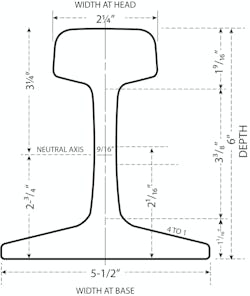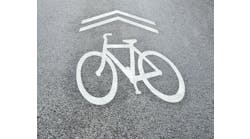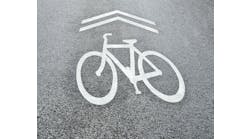Roadway and highway designers have been increasingly turning from dimensional-based, three-dimensional geometric design criteria to performance-based analysis approaches. Historical approaches of using vehicular capacity and meeting nominal design criteria are giving way to multimodal solutions established via performance-based evaluations to guide project decision making.
“Performance-based practical design” has been embraced by the Federal Highway Administration (FHWA) and is being integrated by many transportation agencies to quantify and/or support project design decisions. Performance-based approaches recognize designers must consider various users and balance the needs and performance for each unique context. Our industry is increasingly considering factors beyond capacity-based mobility to guide project decisions and multimodal quality of service, and quantitative safety performance measurement is central to evolving roadway design activities.
Interest in connected and automated vehicles (CAVs) is advancing as fast as the technology associated with smart vehicles and infrastructure. CAVs ultimately will result in measureable benefits in traffic safety and efficiency, but the actual implementation of self-driving, fully automated vehicles will occur incrementally over time. The sequence will generally range from “connected drivers” (smartphones and crowd-sourced traffic applications, such as Waze) to “automated vehicles” where computers replace or augment human driver vehicle operation and control (e.g., adaptive cruise control). Autonomous vehicles are intended to incorporate connectivity and/or automation to allow vehicles to operate with little to no human assistance.
Fundamentally, roadways have been designed for human beings by providing predictable and consistent features to meet user expectations and avoid conflicts. In time, CAVs and technology integrated in roadway infrastructure may result in future designers applying criteria meant to serve vehicles and technology. Until that time comes, our geometric design approach and criteria will remain focused on meeting the needs of human beings, adapting incrementally over time commensurate with technological advances that result in safety and operational benefits.
Image: Lee Rodegerdts, used with permission.
Geometric highway design overview
Modern roadway geometric design evolved from railroad engineering. In railroad engineering, physics and dynamics principles are paramount. Heavy rolling stock travelled on comparatively light metal rails that were attached to timbers set in ballast. Lateral forces needed to be gentle to keep the engine and cars from unseating and tearing up the rails. This led to horizontal curve radii commensurate with desired operating speeds combined with super-elevation (banking) to keep the rolling stock from tipping over. Spiral curves (curves with a constantly changing radius) were used to implement the super-elevation as transitions between tangent and curved rail sections. Low power-to-weight ratios and braking needs limited maximum rail grades. A primary design emphasis was developing flat grades and curves for smooth changes in speed.
Early automobiles were essentially motorized wagons. Design considerations were focused primarily on quality of travel and adapting to weather-related issues. Vehicle speeds and traffic volumes were low, and quality of travel and year-round use were top priority. Vehicle ownership and vehicle operating speeds and volumes grew over time as motorized vehicles became a dominant transportation mode in the U.S. From the 1920s, and especially after World War II, vehicle designs advanced, speeds increased, and highway and street design practices evolved steadily to react to and adapt to changing volumes and speed conditions. During these years, transportation policies emphasized design uniformity and consistency on similar roadway types between states and counties. This allowed consistent construction practices, dependable materials and a uniform experience for roadway users across the country.
Standards in roadway design allowed uniform and consistent facilities regardless of jurisdictional boundaries.
Roadway geometric design is based on human needs compared to the physics-based needs of railroads. A primary goal of roadway geometric design is to provide predictable experiences and consistent features to meet anticipated user expectations. Design controls and features were established to:
- Avoid conflicts by providing, in general, stopping sight distance and sight lines at intersections;
- Account for vehicle travel paths via lane widths accommodating for various design vehicles, and float and drift between markings; and
- Provide driver comfort and security by keeping lateral acceleration below uncomfortable levels.
These three goals are met in three-dimensional roadway geometric designs via:
- Horizontal alignment that addresses curve dynamics and forces, and horizontal offset sight distance;
- Vertical alignment that provides adequate sight distance and driver comfort at crest curves or headlight demands at sag curves; and
- Cross-section configurations that address lane and shoulder width and provide offsets to physical elements or adjacent users (bicyclists or parked cars).
What happens when we take out the human equation in roadway design consideration and begin designing for vehicles instead of human beings? When and how do we begin this transition in design philosophy?
Basic schematic of a railroad rail.
Standards and safety
The dimensional values associated with design standards were first established to provide uniform and consistent roadway designs. They were tools to help professionals match criteria to similar design environments, and they were criteria that represented the standards of care for our profession. But over time, standards have become surrogates for safety. Are the following statements true?
If it meets standards, it must be safe.
If it doesn’t meet standards, it is not safe.
If there is no standard for it, it must not be allowable.
If a design variance from standards is needed, it must be “bad.”
If we meet standards, we will not be liable or subject to legal action.
Transportation safety, as measured by crash frequency and severity, is a continuum, not an absolute. Attaining nominal design values does not necessarily represent substantive safety. For example, for an assigned horizontal curve radius of 500 ft, is a 499-ft radius curve substantially less safe than a 500-ft radius curve?
Quantitative safety performance and multimodal quality-of-service evaluations are substantial evolutions in measuring project performance beyond vehicular capacity and nominal safety. AASHTO’s Highway Safety Manual, First Edition (HSM) supports performance-based planning and design. This advances geometric design from using nominal safety to guide our designs, towards considering objective, substantive safety. Objective, substantive safety is different than security. For example, roundabouts may make some users uncomfortable (not secure). However, objectively, research shows roundabouts reduce crash frequency and severity.
The AASHTO HSM also supports evaluation approaches that move away from reactive safety (i.e., chasing black spots) to proactive safety including crash prediction and integrated crash systems. Connected and autonomous vehicles and smart infrastructure are parts of these systems. However, until technology fully advances these systems, we must continue to account for and design for human beings.
A continuum for safety-focused design. Image courtesy: KAI
Role of CAVs in geometric design
Roadway geometric design elements (horizontal alignment, vertical alignment, cross section) are designed for humans to provide consistent facilities that manage conflicts and meet user expectations. Wikipedia defines an autonomous car (also known as a driverless car, self-driving car, robotic car) as “ . . . a vehicle that is capable of sensing its environment and navigating without human input.” So what are geometric design needs when we design for vehicles and not humans?
Many research documents and reports on CAVs emphasize capacity considerations and benefits on roadway segments, intersections and the broader roadway network associated with automated parking or a shared economy where there may be lower individual vehicle ownership. However, some of the most significant opportunities coming from CAVs relate to safety performance. CAV integration with roadway infrastructure creates significant opportunities to reduce the type, number and severity of crashes related to:
- User to user (vehicle to vehicle; vehicle to pedestrian or bicyclist; vehicle to motorcyclist);
- User types (operational performance between small and large vehicles, emergency vehicles);
- Vehicle and roadway (intersection conflicts or supporting prudent operating speeds); and
- Land-use contextual conflicts (rural, suburban, urban, city center).
It is clear that advances in vehicle and infrastructure technology will reduce the crash risk associated with human factors and driver behavior. How do we best change our roadway geometric design approaches over time to take advantage of commensurate technological changes? Are we at risk of investing in a magnitude and type of infrastructure along the way that may be more robust and resilient than what we may ultimately need?
Horizontal curve design factors for impactful road design.
Temporal considerations
All of these changes are not going to happen at once; however, we have been here before. In the late 1800s, our urban communities adapted and integrated rail and trolley systems during times when horse-drawn carts and wagons were more commonly used. With the expansion of motorized vehicle use in the early 1900s, there was an overlap with horse-drawn vehicles. As we did during those times, in the future we will need to adapt until such time as technology brings a homogeneous mix of vehicles.
Over time, we will see the benefits of a continually evolving fleet and of communications technology integrated in our infrastructure. We will see incremental safety performance benefits as smart vehicles get smarter and become a greater portion of our vehicle fleet. Smart vehicles will benefit from connections to other users and the surrounding infrastructure. Over time, we will move to advanced smart and autonomous vehicles for maximum safety, efficiency and operational performance.
Roadway geometric design will continue to be based on and build from human-based design criteria. As technology changes, we can adapt our design approaches and benefit from more cost-effective and efficient designs. Much of what is documented about CAVs relates to operational efficiency. However, considering public health and the societal costs of severe and fatal crashes, safety performance will be a crucial outcome of adaptation. This may first begin with focusing on the most vulnerable users to support multimodal planning and construction. The incremental advancement of CAV technology will invariably expand support to individual users as connectivity increases.
Over time, smart roadways will integrate information exchanges between vehicles and infrastructure. Technological advances will ultimately lead to more streamlined and efficient transportation infrastructure. This will provide capital cost savings paralleling the improvements in safety and operational performance. Our design processes will need to adapt, and our industry must lead the way in advancing research for new and evolving design methods and approaches.
There are many questions remaining that will need to be answered. Our legislature is often reluctant to invest in new infrastructure, programs and systems. Attitudes that limit government funding have resulted in a backlog of deferred maintenance of our current assets. Our people will buy or pay to use advanced vehicles, but how will we pay for the infrastructure? Which of our wide range of local to national agencies will implement these advances? Who will be willing to pay for it? And finally, is society willing to pay to maintain it?
It is an exciting future when changes in communications, computing, modeling, simulation and interdisciplinary collaboration may invigorate our industry by drawing in new, emerging professionals. Multimodal roadway geometric design will evolve over time, continuing to consider and integrate human factors. Performance-based geometric design will become the norm, adapting performance metrics with technological advances. Cross-discipline collaboration will be especially important to inform geometric design controls and criteria. Public/private research programs could jointly account for temporal demands of getting from the “smart” technology of today to the fully connected/autonomous equipment of the future. This means shared funding approaches in public, vehicle and transportation providers will be critical to support the incremental steps toward full technological implementation. We can do this because our industry is resilient and creative.
Nominal vs. substantive safety concepts based on design. (NCHRP Report 480)
---------------
Ray is a senior principal engineer with Kittelson & Associates Inc.



